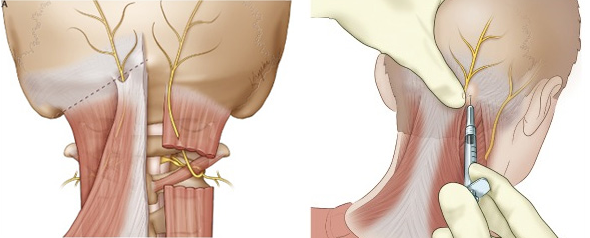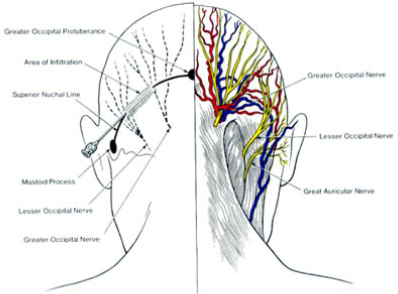Occipital Nerve Blocks
Occipital Nerve Blocks
Occipital neuralgia (nerve pain) is pain in the back of the head or neck and is typically the result of a pinched nerve root in the neck from conditions such as arthritis, or from a tightening of the muscles at the back of the head can entrap the nerves.
The role of an Occipital Nerve Block is to lessen signals from occipital nerves that are located just above the neck that causes migraines. The steroid that is injected reduces inflammation of the region around the nerves just above the neck.
How do Occipital Nerve Blocks Work?

Occipital Nerve Blocks are an injection of a combination of anesthetic and steroid around the scalp that is made to treat migraines. Its purpose is to target nerves in the upper neck that is causing pain and discomfort.
- You will be asked to lay on your back.
- A general anesthetic will be used to numb the area and following this, the steroid injection is given.
- Post-assessments will be carried out.
How long do Occipital Nerve Blocks last for?
It is different for everyone – for some people it lasts for a week however in others, the effects can last for a few months. Therefore, the injections themselves can be given a week apart, however, a maximum of 3 Occipital Blocks in 6 months is recommended.
It seems to be of more help to people who have sudden short onsets of pain rather than someone who has had long lasting pain. However, if the pain can’t be helped then perhaps the Occipital Nerve isn’t the root of the problem.

Who is a candidate for Occipital nerve blocks?
Occipital nerve blocks can help manage the pain affecting the back or side of the head or neck. Potential candidates are those who have suffered with such pain over time with no relief from other treatments. These blocks are effective in treating the inflamed or injured nerve that is causing pain often described as a shooting, stinging, or burning sensation.
Additionally, those who suffer chronic headaches, migraines or other painful conditions connected to nerve inflammation in the head or neck are good candidates for an Occipital nerve block.
Side Effects
The procedure is well known for minimal risk; however, there are some small side effects. Some people have reported pain in the area that was injected – this isn’t long lasting and should disappear within 24 hours. Following the procedure, some people have reported that the head feels numb and they feel faint and dizzy – this is also only temporary.
There is a chance that head pain can worsen and quite worryingly this occurs in 1/30 patients.
Other side effects include:
- Bleeding
- Allergic reaction to the injection
- Nerve Damage
- Infection
However, these are very rare side effects.
Will the Occipital nerve block be painful?
No, it will feel similar to a blood test as you are also given an anesthetic to numb the pain. However, being sedated and using an anesthetic is completely different so you may be awake during the procedure but may feel numb and be unable to speak or move.
It also only takes 24 hours to heal so many people are able to go back to work the next day. However, ensure that you take daily activities easy because it could disrupt the healing process.



